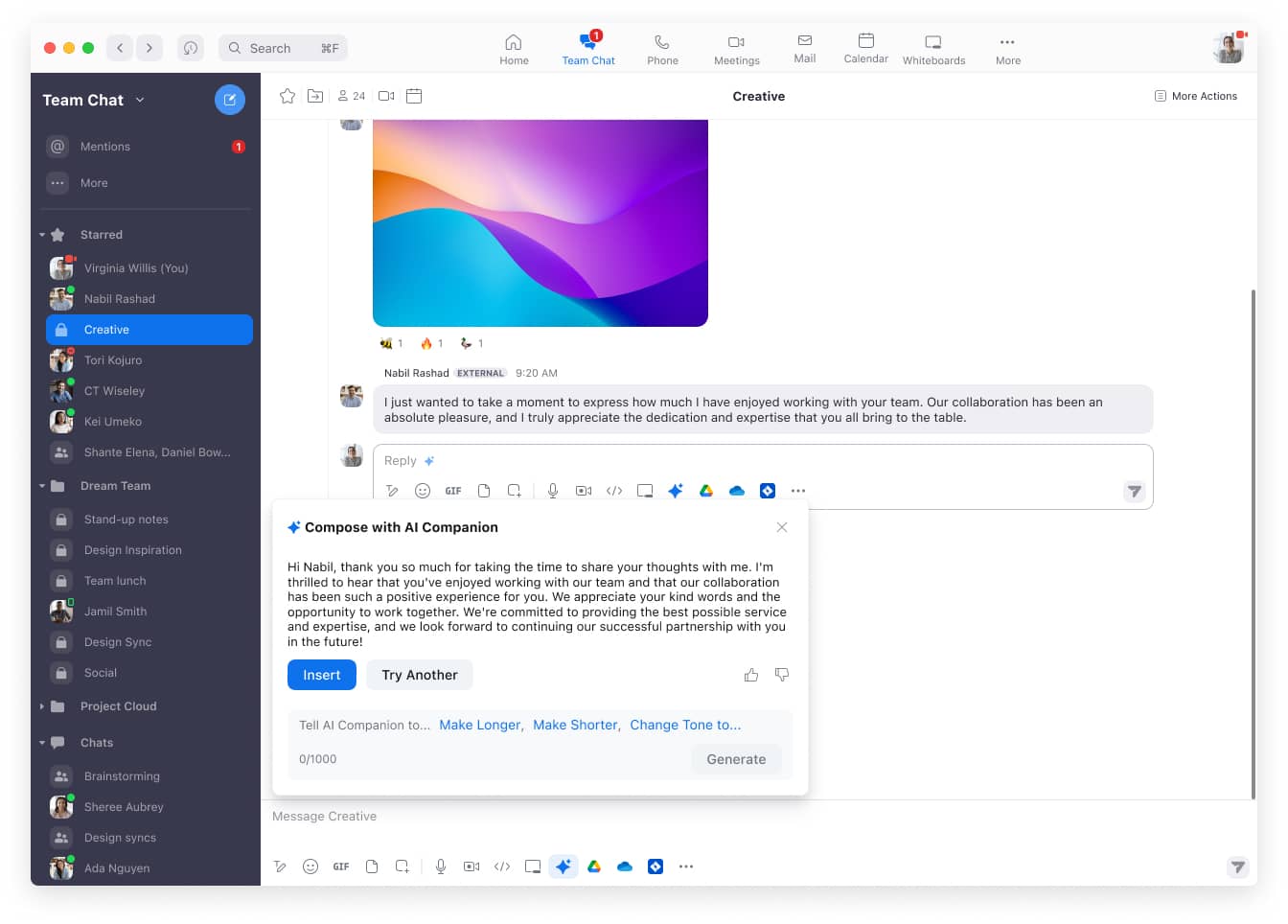
How to make the most of Zoom AI Companion: Your guide to getting started with your AI assistant
Your guide to enabling Zoom AI Companion and using its features to help improve productivity and collaboration.
Learn the benefits of using AI writing tools to help save time, improve productivity, and improve your business communications.
Updated on February 13, 2025
Published on February 12, 2024


Everyone has that dreaded work task they’d rather push off to the next day (and the next, and the next). For some people, that task is business writing: drafting emails to clients or prospects, sending project updates, or even just writing up a meeting agenda for your team. If a blank email draft or chat window immediately puts you in procrastination mode, or if too much of your day is spent composing messages, AI writing tools might be just what you need to tackle your to-do list.
Using AI for writing can help you save valuable time in your workday by effectively drafting messages for you. Before you dive into using some of the apps out there, it can be helpful to know how they work and what they can help you with. Learn the basics and see how you can benefit from using AI for your writing needs.
In order to get a grasp of how AI writing tools work and what they do, it’s helpful to know terms like “generative AI” and “large language models” (LLMs). Here’s a quick breakdown:
AI writing tools use LLMs to generate text outputs based on human inputs, or prompts. Put more simply, you can describe what kind of message you want to the AI model (the input) and it will string words together into a message (the output) that should fit your prompt.
There’s no shortage of generative AI tools available to help you draft virtually any type of message. You can use AI to generate short-form content like ad copy, a social media post, or an email. You can also leverage AI to write long-form content such as a letter to your insurance company or to compose your business communications. Here are just a few of the benefits of using AI to help you create high-quality content.
Sometimes, getting started on a task is the hardest part. Especially when you’re facing a blank page. An AI writing tool can spin up a first draft in a few seconds, and even if it’s not exactly what you’re looking for, you might find yourself more willing to dive into a task when you’ve got something to work with. Making some tweaks to a draft can feel a lot more manageable than starting from scratch. Or, you can add more detail to your prompt and have your AI tool generate another draft.
Churning out a few dozen cold sales emails or follow-up chat messages can take hours. Use your trusty AI writing assistant to draft those repetitive messages, tailored to each recipient, in a fraction of the time.
You wouldn’t speak to the CEO of a company you’re trying to close a deal with in the same way you’d talk to a colleague. Even if your message is the same, the way you say it may be slightly different, which is why tone is such a critical part of writing. AI writing tools don’t just generate text, they also have the ability to use word choice to strike the right tone of voice. Tweak your prompt to ask your AI writer to sound “more persuasive,” “friendlier,” or “more serious” depending on the message recipient or situation.

If you’re stuck in a rut when it comes to emails and subject lines, your AI writing assistant can help you come up with some new ways to say the same thing. Get creative with your prompt, asking it to “write email subject lines that incorporate puns about ABC Widgets” or “draft a follow-up email that mentions my client’s love of snowboarding.” The resulting message could spark an idea for a different prompt or inspire you to branch out from your regular communication style.
We all know how mentally draining it can be to spend most of your workday on tedious tasks. By leaving the writing up to your AI content generator, you can free up more time to work on tasks that require critical thinking and creativity — skills that are uniquely human.
The best AI writer for you will be one that fits into your workflows seamlessly while allowing you to be more productive. Depending on what kind of work you do, you might want to use a specific tool or app built for that type of writing. There are AI writing tools to help with blog posts, copywriting, product descriptions, marketing campaigns, and even event content.
But if you’re looking for help with your everyday business communications like emails and chats, an AI assistant might be what you need. Bonus points if it’s built into the tools you already use on a daily basis.
Many AI-powered writing tools work in similar ways. You might see a text box where you can type in prompts and a window where the generated text will appear. You often just need to follow a few basic steps to get the message you need:
If you want to improve your communication and enhance your productivity at work, Zoom AI Companion has the ability to generate messages for you in Zoom Mail and Zoom Team Chat. This can help ease the burden of responding to the many messages in your email inbox and chat app.
Because AI Companion is part of the Zoom platform for available plans, not a separate tool, all you have to do is look for the AI Companion icon in Team Chat or in Zoom Mail to get started. Click on the AI Companion sparkle icon to get help composing messages based on your prompt, using context from previous chats or emails. Our federated approach to AI incorporates different LLMs depending on the task to provide high-quality results.
You can review the draft and make it shorter or longer, change the tone, or edit it to give it a personal touch.

Let Zoom’s AI writing features help you knock some of those tasks off your to-do list, giving you the space and time to concentrate on more meaningful work.
If you’re new to AI Companion, check out our guide to getting started with your AI assistant. Haven’t tried AI Companion yet? It’s included at no additional cost with eligible paid accounts. Zoom Workplace Basic users can sign up for an eligible paid plan here.*
*Note: AI Companion may not be available for all regions and industry verticals